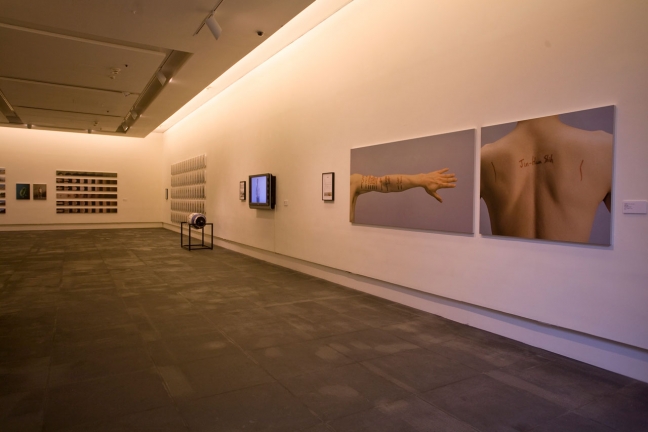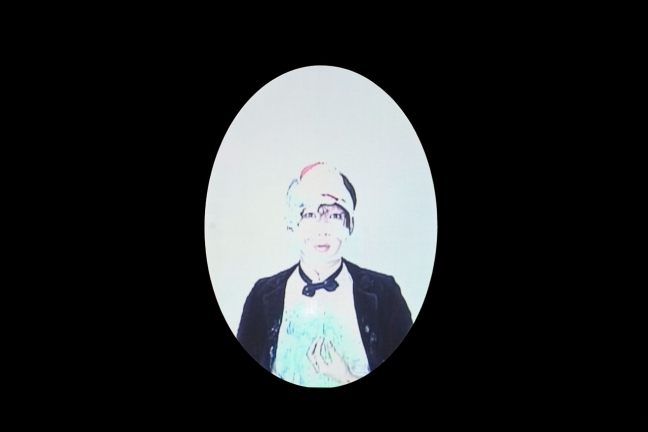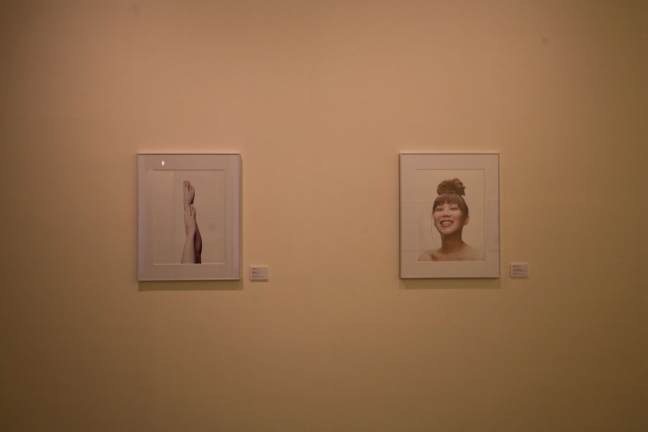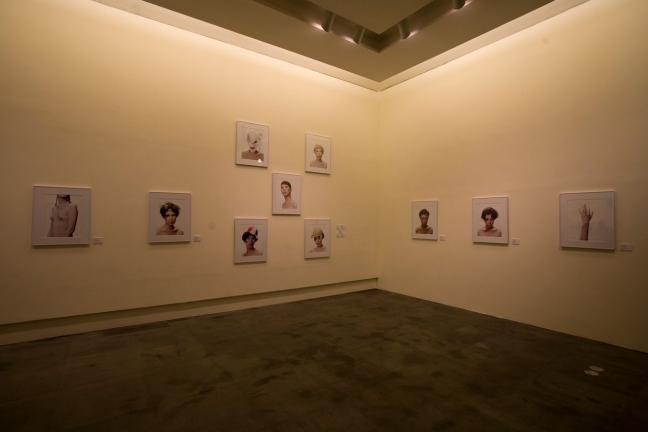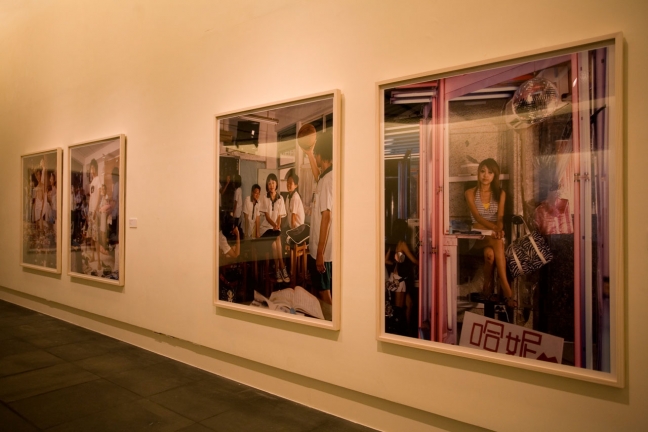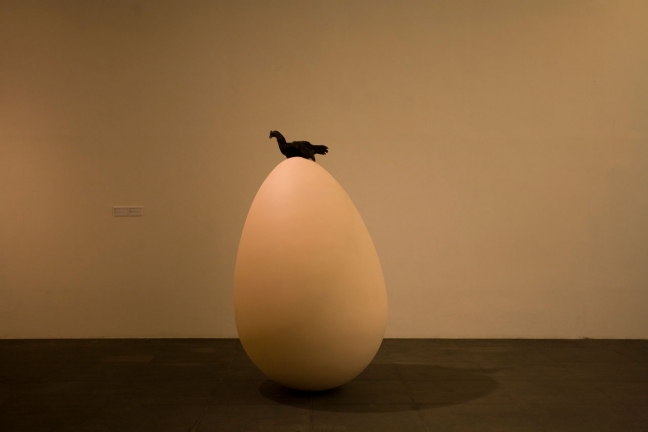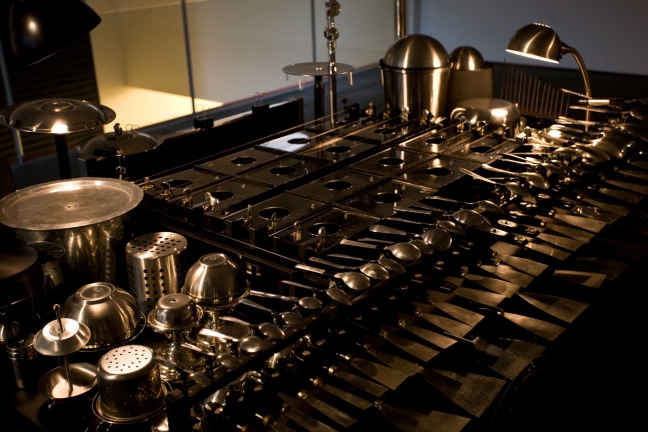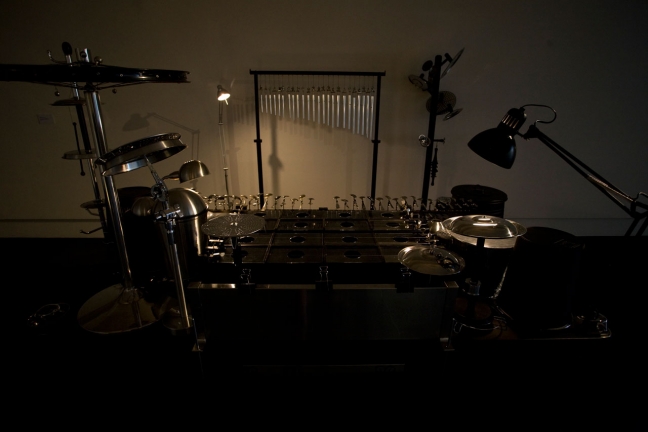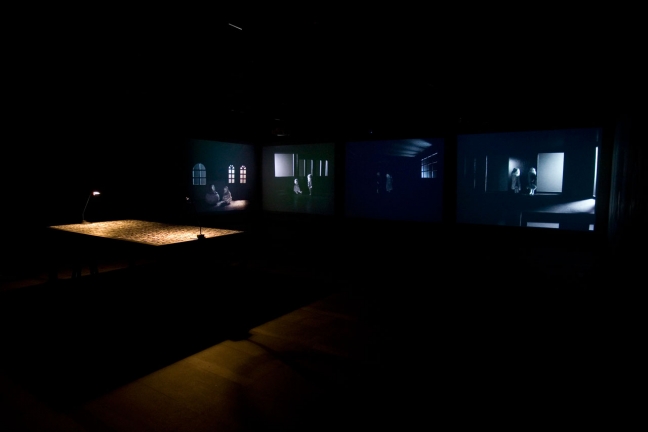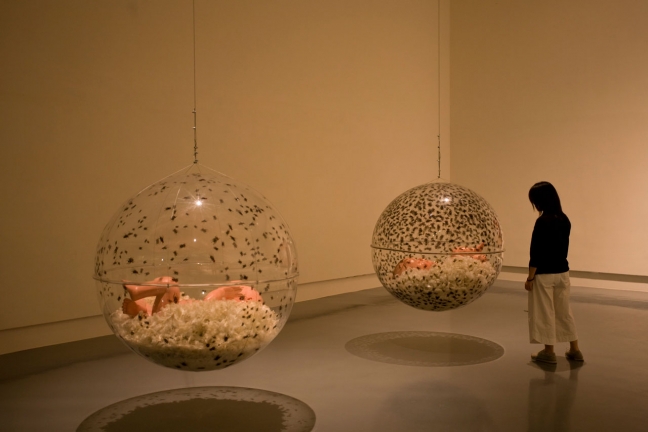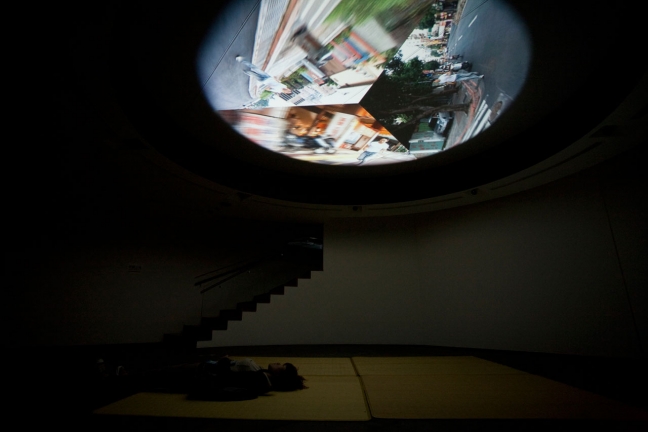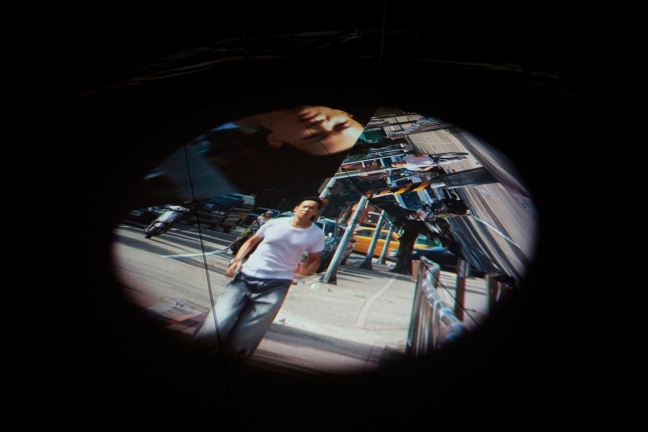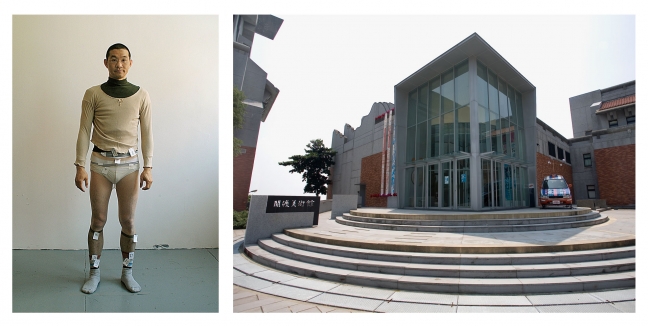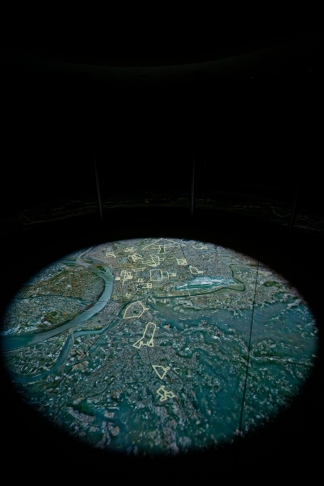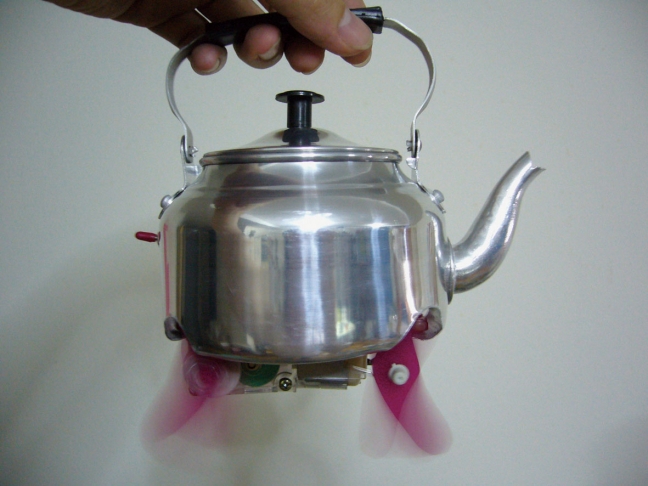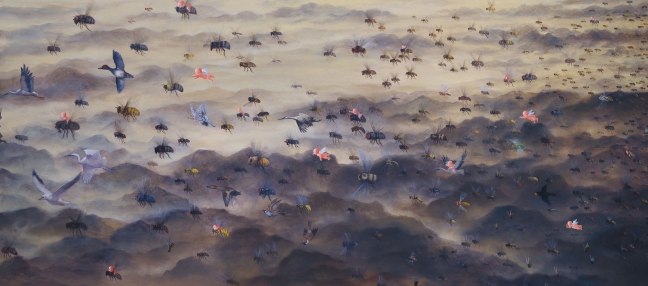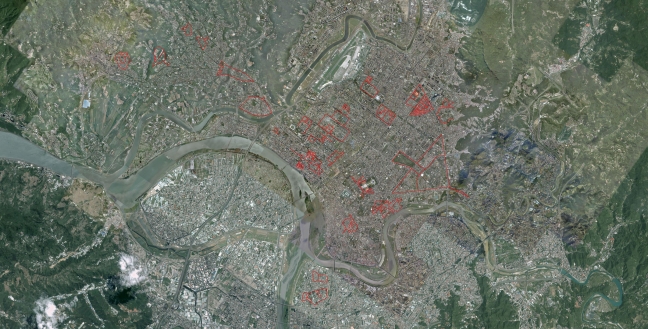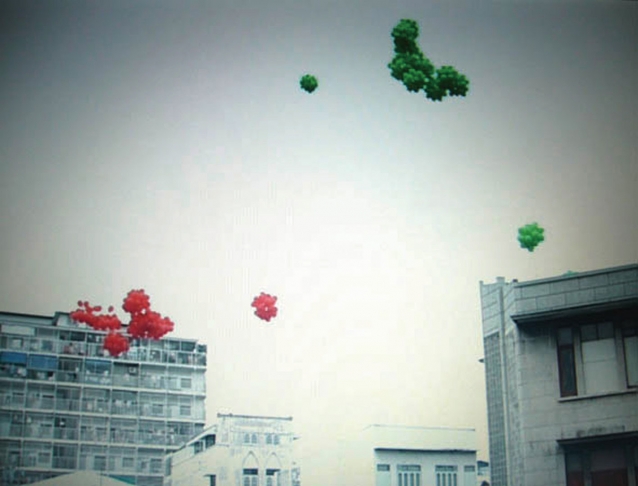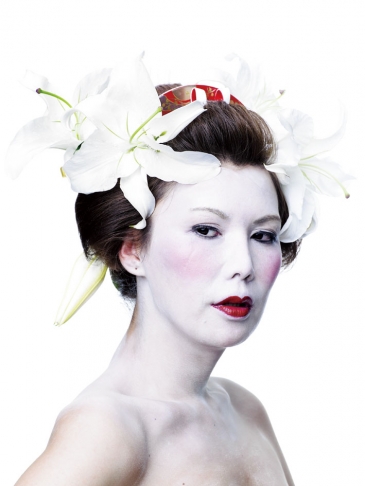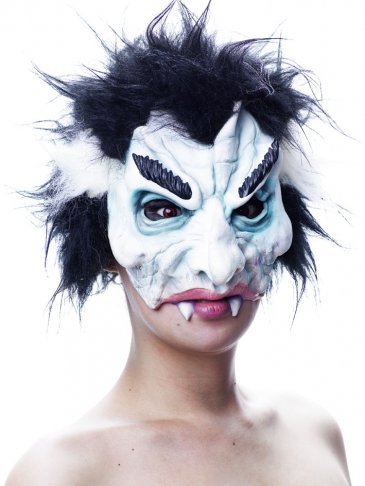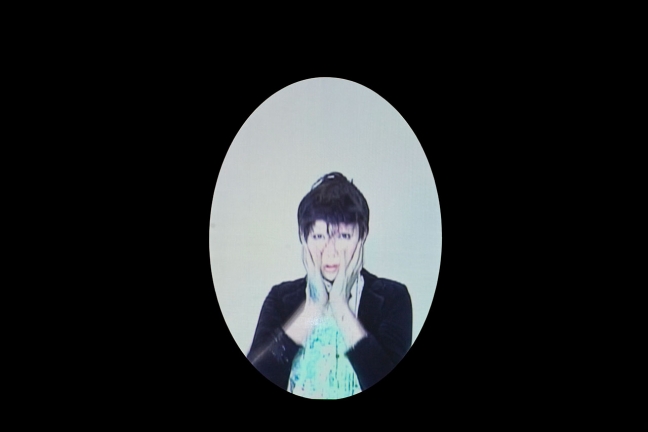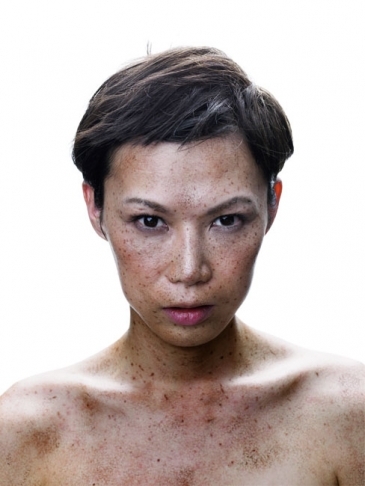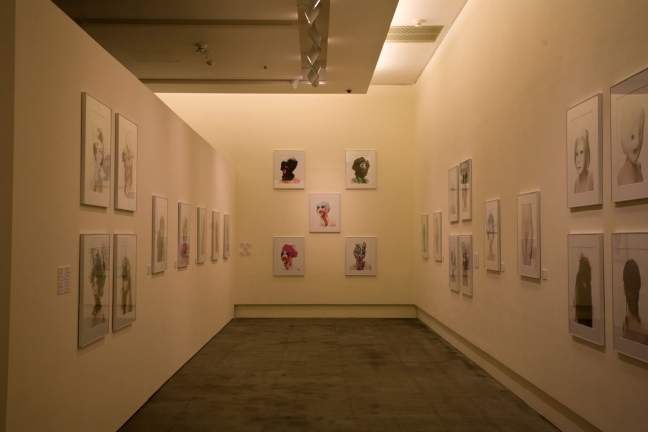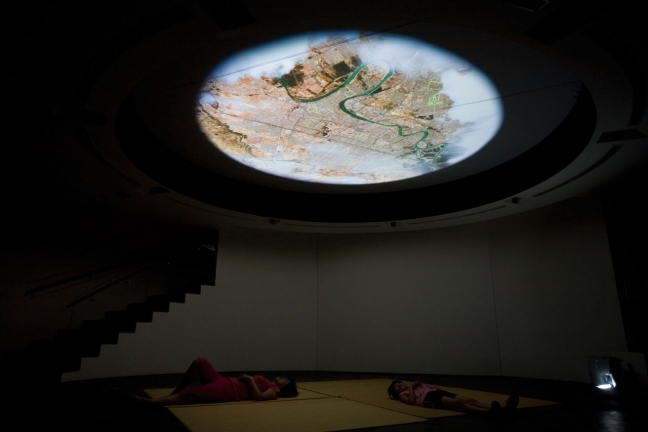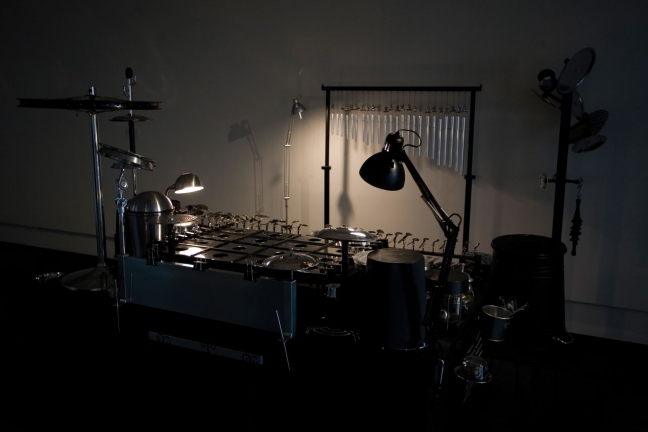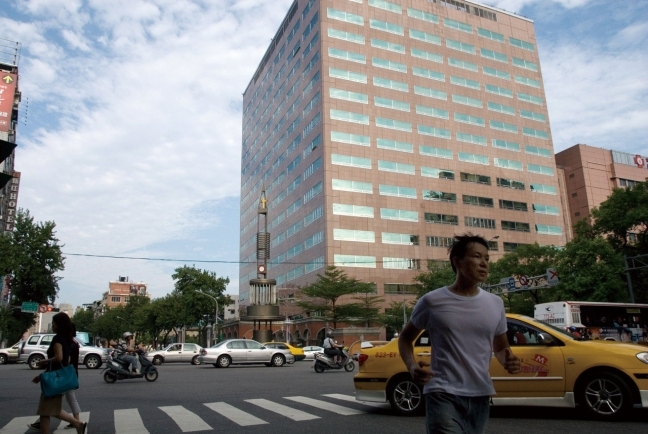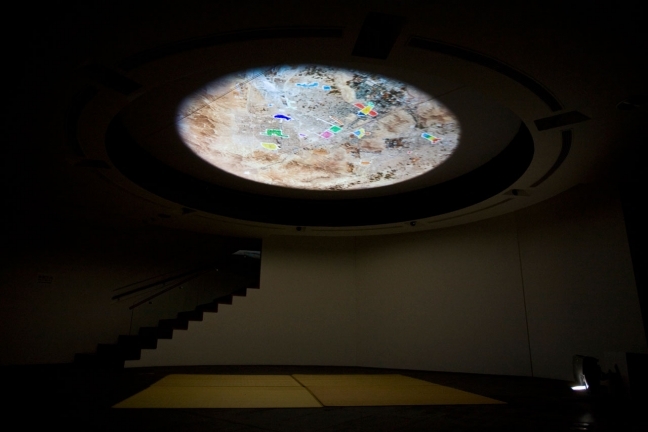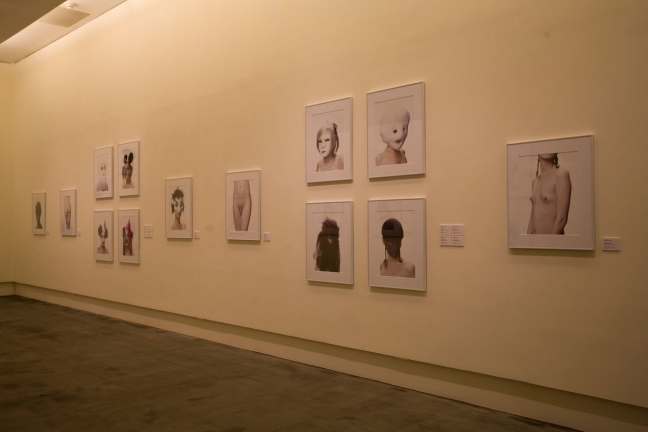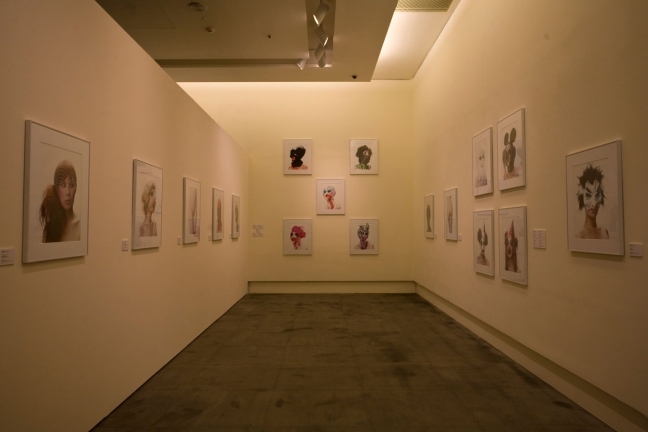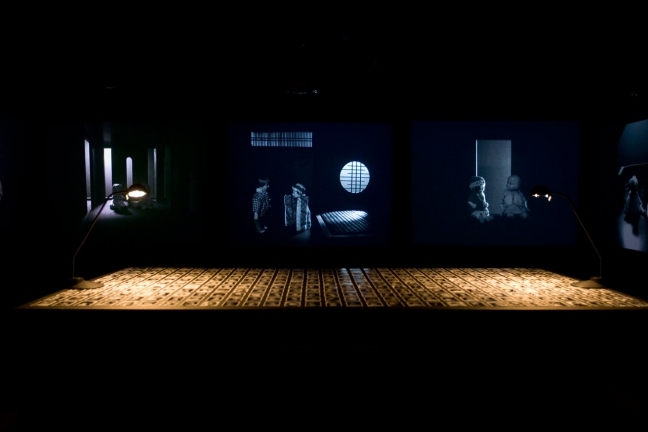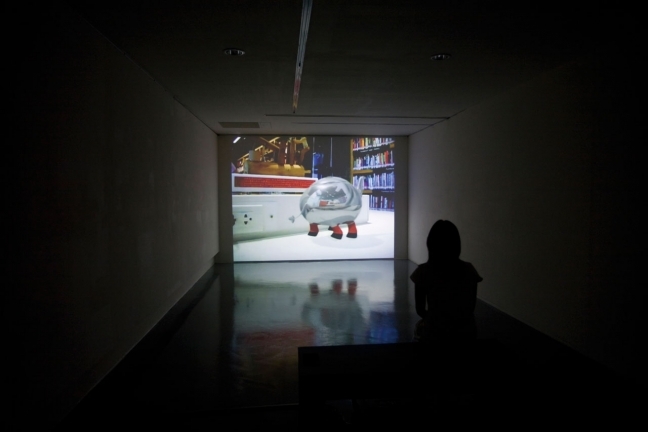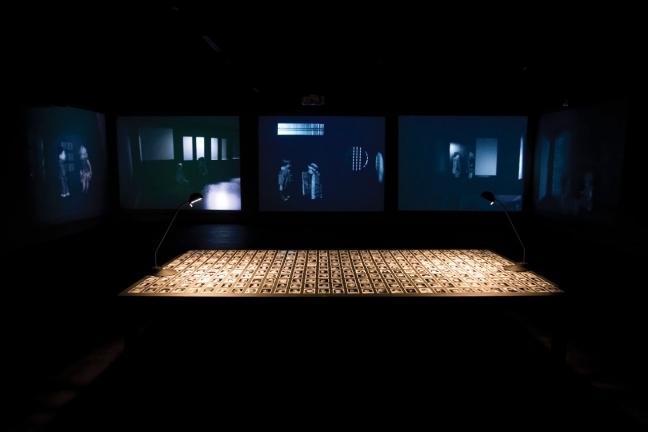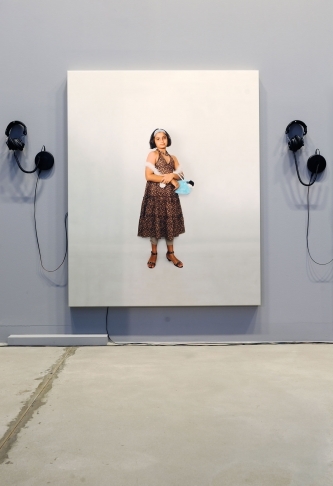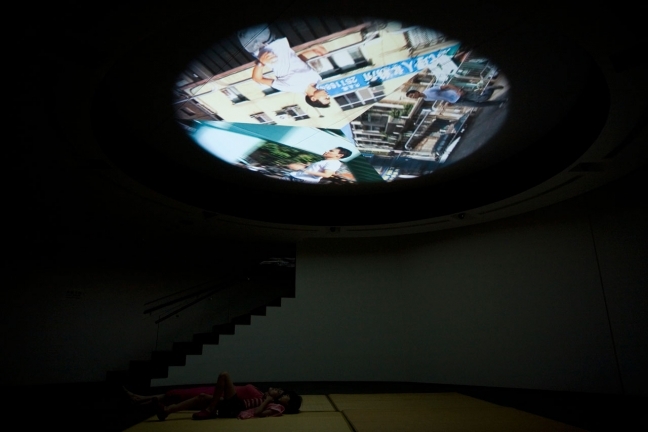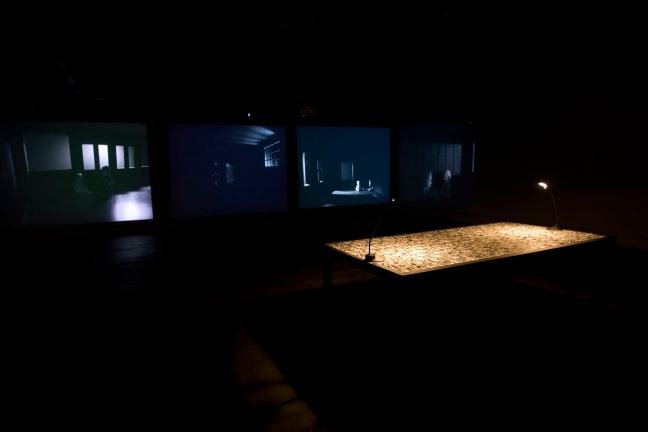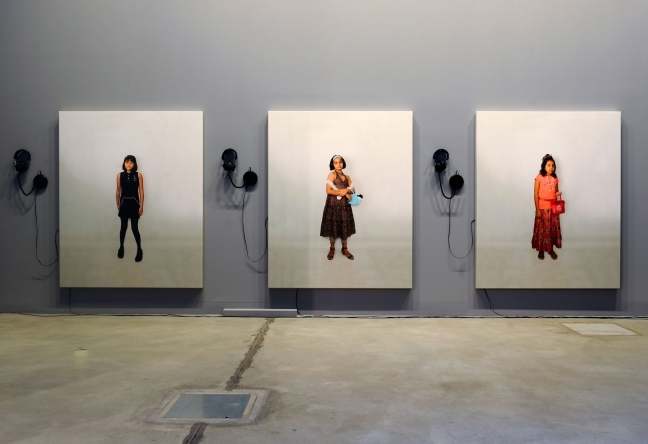I have a Dream-10 Solos by 10 Asia Artists
2008.09.26~2008.11.30
09:00 - 17:00
The
Kuandu Biennale 2008” serves as the premiere program of this year’s Kuandu Art Festival, and it is also the first biannual exhibition to be held at the Kuandu Museum of Fine Arts. Unlike other similar exhibitions, this biennale especially invites prominent local curators and scholars to establish a consulting committee to select ten participating artists from overseas based on a recommendation list. Then, each artist proposes his or her curator or critique, in hope of forging a direct-inter changing art platform. Besides the ten solo exhibitions, the organizers will also host a forum for discussion on which every curator and art critique will offer a discourse detailing his or her artist and the selection process. The invited local scholars will also hold panels of discussion with foreign curator and critiques to foster a better interchange of experiences. A solo exhibition emphasizes the continuity and integrity of personal art creation. Kuandu Museum of Fine Arts chooses
solo” as a form of demonstration for each artist’s personal exhibition and in an attempt to construct, connect, and amalgamate the energy field of the solos so as to congregate and juxtapose the real-time profile and status quo of their creation, forming a web of the most current art forms. Through a strategic integration of artists, curators, art critiques and art space, this exhibition mechanism very practically interconnects a cultural value system characterized by very different geography, ethnic groups, religions, and languages. The exhibition platform is envisaged to bring out dialogues, communication, interchange and sharing, which could facilitate an accumulation of creative energy and discourse repository, exploring all possibilities and opportunities of
sharing” among different Asian artists. With
dream” as the theme of the biennale, the exposition strings solo exhibits created by ten Asian artists, structuring an interchange network for future cooperation. Everybody dreams of certain goals, but not everyone tries to achieve them,
The Kuandu Biennale 2008” works as the locus to string the dreams of different artists from different Asian countries, initiating a multifaceted,
dream-related” practice of art. Artists put their dreams into practice and also bring out queries on the
potential” of their environment as well as how Asian societies should become self-aware of themselves while facing major global changes. The biennale envisages fulfilling the artists’ dreams to the maximum limit through their works, which can be an experiment of dreams, a window of sub-consciousness, a fantasy of body and soul, a rhapsody by artists, a loss of memories, or even a supernatural interpretation of dreams. Among the artists, having finished almost a hundred
Dream Projects” all over the world, New Media artist from Korea, Yeondoo Jung selected two particular cases from a hundred dream wanted questionnaires in Taiwan, which he has already made into films. One of the two finalized cases depicts a
betel nut” girl’s dream: She wants to relive her elementary school days when she could play around or study together with her classmates without any worries. The other case probes into a male university student’s fantasy in which he would lead the luxurious life of a king in a palace served by many beautiful maids-in-waiting. The Vietnamese artist Jun Nguyen-Hatsushiba uses
running” as the sign of actions to symbolize the refugees around the world. Jun employs the map of Taipei city and runs on the routes bass on children’s drawings. The running is recorded on satellite aerial map which gives Taipei City Street an imaginable icon that looks like brooch on the earth. Donna Ong, the young generation artist from Singapore uses spoon, scraper, pots, bowls, ladle, pots, barrels, as well as wheel on bicycles to the composition of young girls’ dreams of a drum which is visually vivid with clear sounds; She studies and collect the diplomatic dolls which were exchanged between United States and Japan yet destroyed during World War II to satirize the grief and cruel that wars have gave to people. If the greatest dream in life is to change the gender, then it seems someone has to grab it hardly from God. The series of the self-portraits formed by the Japanese artist Pyuupiru are cruelly presented how
he” became
her” during the process of degeneration. The young Taiwan artist Isa Ho who tends to dress in Snow White in her works presents an interesting series of circus photo prints in black and white. To use all parts of the body for measurement, the Taiwanese conceptual artist Shi Jin-hua will presents series of body measurements from last few years. The China artist Fang Lijun displays the oil paintings of the universe in large-scale, and works of the large-scale babies in a transparent sphere. Another India artist Shilpa Gupta, presents dialogues from four Indian girls with their photo prints to interact with the audience. In order to make the concept arts of humor, Indonesia artist Handiwirman Saputra created sculptures of life-size chickens and large eggs to show their funny relationship among them. By using different colors of balloons as a symbol of peace into different area in Thailand, the Thailand artist Porntaweesak Rimsakul shows Thailand's recent ethnic conflicts. Using
dream” as the theme of the exhibition, the ten solo exhibitions connect with one another as a chain. In the cycle of perception, the artists present a multifaceted observation and interpretation of Asian societies: Japan, Korea, China, Vietnam, Singapore, Indonesia, Thailand, India, and Taiwan. The solo exhibitions not only manifest the artists’ individual styles of creation but also offer a transnational and trans-ethnic reference, analysis and comparison. The exhibitions hope to integrate and re-present the unique interpretation and social significance that each of the Asian societies has on
dreams”.
Kuandu Biennale 2008” serves as the premiere program of this year’s Kuandu Art Festival, and it is also the first biannual exhibition to be held at the Kuandu Museum of Fine Arts. Unlike other similar exhibitions, this biennale especially invites prominent local curators and scholars to establish a consulting committee to select ten participating artists from overseas based on a recommendation list. Then, each artist proposes his or her curator or critique, in hope of forging a direct-inter changing art platform. Besides the ten solo exhibitions, the organizers will also host a forum for discussion on which every curator and art critique will offer a discourse detailing his or her artist and the selection process. The invited local scholars will also hold panels of discussion with foreign curator and critiques to foster a better interchange of experiences. A solo exhibition emphasizes the continuity and integrity of personal art creation. Kuandu Museum of Fine Arts chooses
solo” as a form of demonstration for each artist’s personal exhibition and in an attempt to construct, connect, and amalgamate the energy field of the solos so as to congregate and juxtapose the real-time profile and status quo of their creation, forming a web of the most current art forms. Through a strategic integration of artists, curators, art critiques and art space, this exhibition mechanism very practically interconnects a cultural value system characterized by very different geography, ethnic groups, religions, and languages. The exhibition platform is envisaged to bring out dialogues, communication, interchange and sharing, which could facilitate an accumulation of creative energy and discourse repository, exploring all possibilities and opportunities of
sharing” among different Asian artists. With
dream” as the theme of the biennale, the exposition strings solo exhibits created by ten Asian artists, structuring an interchange network for future cooperation. Everybody dreams of certain goals, but not everyone tries to achieve them,
The Kuandu Biennale 2008” works as the locus to string the dreams of different artists from different Asian countries, initiating a multifaceted,
dream-related” practice of art. Artists put their dreams into practice and also bring out queries on the
potential” of their environment as well as how Asian societies should become self-aware of themselves while facing major global changes. The biennale envisages fulfilling the artists’ dreams to the maximum limit through their works, which can be an experiment of dreams, a window of sub-consciousness, a fantasy of body and soul, a rhapsody by artists, a loss of memories, or even a supernatural interpretation of dreams. Among the artists, having finished almost a hundred
Dream Projects” all over the world, New Media artist from Korea, Yeondoo Jung selected two particular cases from a hundred dream wanted questionnaires in Taiwan, which he has already made into films. One of the two finalized cases depicts a
betel nut” girl’s dream: She wants to relive her elementary school days when she could play around or study together with her classmates without any worries. The other case probes into a male university student’s fantasy in which he would lead the luxurious life of a king in a palace served by many beautiful maids-in-waiting. The Vietnamese artist Jun Nguyen-Hatsushiba uses
running” as the sign of actions to symbolize the refugees around the world. Jun employs the map of Taipei city and runs on the routes bass on children’s drawings. The running is recorded on satellite aerial map which gives Taipei City Street an imaginable icon that looks like brooch on the earth. Donna Ong, the young generation artist from Singapore uses spoon, scraper, pots, bowls, ladle, pots, barrels, as well as wheel on bicycles to the composition of young girls’ dreams of a drum which is visually vivid with clear sounds; She studies and collect the diplomatic dolls which were exchanged between United States and Japan yet destroyed during World War II to satirize the grief and cruel that wars have gave to people. If the greatest dream in life is to change the gender, then it seems someone has to grab it hardly from God. The series of the self-portraits formed by the Japanese artist Pyuupiru are cruelly presented how
he” became
her” during the process of degeneration. The young Taiwan artist Isa Ho who tends to dress in Snow White in her works presents an interesting series of circus photo prints in black and white. To use all parts of the body for measurement, the Taiwanese conceptual artist Shi Jin-hua will presents series of body measurements from last few years. The China artist Fang Lijun displays the oil paintings of the universe in large-scale, and works of the large-scale babies in a transparent sphere. Another India artist Shilpa Gupta, presents dialogues from four Indian girls with their photo prints to interact with the audience. In order to make the concept arts of humor, Indonesia artist Handiwirman Saputra created sculptures of life-size chickens and large eggs to show their funny relationship among them. By using different colors of balloons as a symbol of peace into different area in Thailand, the Thailand artist Porntaweesak Rimsakul shows Thailand's recent ethnic conflicts. Using
dream” as the theme of the exhibition, the ten solo exhibitions connect with one another as a chain. In the cycle of perception, the artists present a multifaceted observation and interpretation of Asian societies: Japan, Korea, China, Vietnam, Singapore, Indonesia, Thailand, India, and Taiwan. The solo exhibitions not only manifest the artists’ individual styles of creation but also offer a transnational and trans-ethnic reference, analysis and comparison. The exhibitions hope to integrate and re-present the unique interpretation and social significance that each of the Asian societies has on
dreams”.
The
Kuandu Biennale 2008” serves as the premiere program of this year’s Kuandu Art Festival, and it is also the first biannual exhibition to be held at the Kuandu Museum of Fine Arts. Unlike other similar exhibitions, this biennale especially invites prominent local curators and scholars to establish a consulting committee to select ten participating artists from overseas based on a recommendation list. Then, each artist proposes his or her curator or critique, in hope of forging a direct-inter changing art platform. Besides the ten solo exhibitions, the organizers will also host a forum for discussion on which every curator and art critique will offer a discourse detailing his or her artist and the selection process. The invited local scholars will also hold panels of discussion with foreign curator and critiques to foster a better interchange of experiences. A solo exhibition emphasizes the continuity and integrity of personal art creation. Kuandu Museum of Fine Arts chooses
solo” as a form of demonstration for each artist’s personal exhibition and in an attempt to construct, connect, and amalgamate the energy field of the solos so as to congregate and juxtapose the real-time profile and status quo of their creation, forming a web of the most current art forms. Through a strategic integration of artists, curators, art critiques and art space, this exhibition mechanism very practically interconnects a cultural value system characterized by very different geography, ethnic groups, religions, and languages. The exhibition platform is envisaged to bring out dialogues, communication, interchange and sharing, which could facilitate an accumulation of creative energy and discourse repository, exploring all possibilities and opportunities of
sharing” among different Asian artists. With
dream” as the theme of the biennale, the exposition strings solo exhibits created by ten Asian artists, structuring an interchange network for future cooperation. Everybody dreams of certain goals, but not everyone tries to achieve them,
The Kuandu Biennale 2008” works as the locus to string the dreams of different artists from different Asian countries, initiating a multifaceted,
dream-related” practice of art. Artists put their dreams into practice and also bring out queries on the
potential” of their environment as well as how Asian societies should become self-aware of themselves while facing major global changes. The biennale envisages fulfilling the artists’ dreams to the maximum limit through their works, which can be an experiment of dreams, a window of sub-consciousness, a fantasy of body and soul, a rhapsody by artists, a loss of memories, or even a supernatural interpretation of dreams. Among the artists, having finished almost a hundred
Dream Projects” all over the world, New Media artist from Korea, Yeondoo Jung selected two particular cases from a hundred dream wanted questionnaires in Taiwan, which he has already made into films. One of the two finalized cases depicts a
betel nut” girl’s dream: She wants to relive her elementary school days when she could play around or study together with her classmates without any worries. The other case probes into a male university student’s fantasy in which he would lead the luxurious life of a king in a palace served by many beautiful maids-in-waiting. The Vietnamese artist Jun Nguyen-Hatsushiba uses
running” as the sign of actions to symbolize the refugees around the world. Jun employs the map of Taipei city and runs on the routes bass on children’s drawings. The running is recorded on satellite aerial map which gives Taipei City Street an imaginable icon that looks like brooch on the earth. Donna Ong, the young generation artist from Singapore uses spoon, scraper, pots, bowls, ladle, pots, barrels, as well as wheel on bicycles to the composition of young girls’ dreams of a drum which is visually vivid with clear sounds; She studies and collect the diplomatic dolls which were exchanged between United States and Japan yet destroyed during World War II to satirize the grief and cruel that wars have gave to people. If the greatest dream in life is to change the gender, then it seems someone has to grab it hardly from God. The series of the self-portraits formed by the Japanese artist Pyuupiru are cruelly presented how
he” became
her” during the process of degeneration. The young Taiwan artist Isa Ho who tends to dress in Snow White in her works presents an interesting series of circus photo prints in black and white. To use all parts of the body for measurement, the Taiwanese conceptual artist Shi Jin-hua will presents series of body measurements from last few years. The China artist Fang Lijun displays the oil paintings of the universe in large-scale, and works of the large-scale babies in a transparent sphere. Another India artist Shilpa Gupta, presents dialogues from four Indian girls with their photo prints to interact with the audience. In order to make the concept arts of humor, Indonesia artist Handiwirman Saputra created sculptures of life-size chickens and large eggs to show their funny relationship among them. By using different colors of balloons as a symbol of peace into different area in Thailand, the Thailand artist Porntaweesak Rimsakul shows Thailand's recent ethnic conflicts. Using
dream” as the theme of the exhibition, the ten solo exhibitions connect with one another as a chain. In the cycle of perception, the artists present a multifaceted observation and interpretation of Asian societies: Japan, Korea, China, Vietnam, Singapore, Indonesia, Thailand, India, and Taiwan. The solo exhibitions not only manifest the artists’ individual styles of creation but also offer a transnational and trans-ethnic reference, analysis and comparison. The exhibitions hope to integrate and re-present the unique interpretation and social significance that each of the Asian societies has on
dreams”.
Kuandu Biennale 2008” serves as the premiere program of this year’s Kuandu Art Festival, and it is also the first biannual exhibition to be held at the Kuandu Museum of Fine Arts. Unlike other similar exhibitions, this biennale especially invites prominent local curators and scholars to establish a consulting committee to select ten participating artists from overseas based on a recommendation list. Then, each artist proposes his or her curator or critique, in hope of forging a direct-inter changing art platform. Besides the ten solo exhibitions, the organizers will also host a forum for discussion on which every curator and art critique will offer a discourse detailing his or her artist and the selection process. The invited local scholars will also hold panels of discussion with foreign curator and critiques to foster a better interchange of experiences. A solo exhibition emphasizes the continuity and integrity of personal art creation. Kuandu Museum of Fine Arts chooses
solo” as a form of demonstration for each artist’s personal exhibition and in an attempt to construct, connect, and amalgamate the energy field of the solos so as to congregate and juxtapose the real-time profile and status quo of their creation, forming a web of the most current art forms. Through a strategic integration of artists, curators, art critiques and art space, this exhibition mechanism very practically interconnects a cultural value system characterized by very different geography, ethnic groups, religions, and languages. The exhibition platform is envisaged to bring out dialogues, communication, interchange and sharing, which could facilitate an accumulation of creative energy and discourse repository, exploring all possibilities and opportunities of
sharing” among different Asian artists. With
dream” as the theme of the biennale, the exposition strings solo exhibits created by ten Asian artists, structuring an interchange network for future cooperation. Everybody dreams of certain goals, but not everyone tries to achieve them,
The Kuandu Biennale 2008” works as the locus to string the dreams of different artists from different Asian countries, initiating a multifaceted,
dream-related” practice of art. Artists put their dreams into practice and also bring out queries on the
potential” of their environment as well as how Asian societies should become self-aware of themselves while facing major global changes. The biennale envisages fulfilling the artists’ dreams to the maximum limit through their works, which can be an experiment of dreams, a window of sub-consciousness, a fantasy of body and soul, a rhapsody by artists, a loss of memories, or even a supernatural interpretation of dreams. Among the artists, having finished almost a hundred
Dream Projects” all over the world, New Media artist from Korea, Yeondoo Jung selected two particular cases from a hundred dream wanted questionnaires in Taiwan, which he has already made into films. One of the two finalized cases depicts a
betel nut” girl’s dream: She wants to relive her elementary school days when she could play around or study together with her classmates without any worries. The other case probes into a male university student’s fantasy in which he would lead the luxurious life of a king in a palace served by many beautiful maids-in-waiting. The Vietnamese artist Jun Nguyen-Hatsushiba uses
running” as the sign of actions to symbolize the refugees around the world. Jun employs the map of Taipei city and runs on the routes bass on children’s drawings. The running is recorded on satellite aerial map which gives Taipei City Street an imaginable icon that looks like brooch on the earth. Donna Ong, the young generation artist from Singapore uses spoon, scraper, pots, bowls, ladle, pots, barrels, as well as wheel on bicycles to the composition of young girls’ dreams of a drum which is visually vivid with clear sounds; She studies and collect the diplomatic dolls which were exchanged between United States and Japan yet destroyed during World War II to satirize the grief and cruel that wars have gave to people. If the greatest dream in life is to change the gender, then it seems someone has to grab it hardly from God. The series of the self-portraits formed by the Japanese artist Pyuupiru are cruelly presented how
he” became
her” during the process of degeneration. The young Taiwan artist Isa Ho who tends to dress in Snow White in her works presents an interesting series of circus photo prints in black and white. To use all parts of the body for measurement, the Taiwanese conceptual artist Shi Jin-hua will presents series of body measurements from last few years. The China artist Fang Lijun displays the oil paintings of the universe in large-scale, and works of the large-scale babies in a transparent sphere. Another India artist Shilpa Gupta, presents dialogues from four Indian girls with their photo prints to interact with the audience. In order to make the concept arts of humor, Indonesia artist Handiwirman Saputra created sculptures of life-size chickens and large eggs to show their funny relationship among them. By using different colors of balloons as a symbol of peace into different area in Thailand, the Thailand artist Porntaweesak Rimsakul shows Thailand's recent ethnic conflicts. Using
dream” as the theme of the exhibition, the ten solo exhibitions connect with one another as a chain. In the cycle of perception, the artists present a multifaceted observation and interpretation of Asian societies: Japan, Korea, China, Vietnam, Singapore, Indonesia, Thailand, India, and Taiwan. The solo exhibitions not only manifest the artists’ individual styles of creation but also offer a transnational and trans-ethnic reference, analysis and comparison. The exhibitions hope to integrate and re-present the unique interpretation and social significance that each of the Asian societies has on
dreams”.



